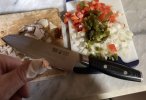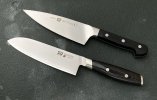mbkr
Gold Member
- Joined
- May 20, 2018
- Messages
- 8,447
Yup, its sharp 
First time using it

Other than a paring knife here and there, I don't believe I've ever bought a kitchen knife. Always made do with hand me downs and gifts. Bought these two a couple of weeks ago. Nothing fancy or too extravagant. Zwilling Pro 6" Chef and the 6.5" Yaxell Mon santoku, a.k.a. "thumb killer"

So far, I like the Zwilling better, but that's mostly because it hasn't attacked me
Merry (and hopefully not too bloody) Christmas!


First time using it

Other than a paring knife here and there, I don't believe I've ever bought a kitchen knife. Always made do with hand me downs and gifts. Bought these two a couple of weeks ago. Nothing fancy or too extravagant. Zwilling Pro 6" Chef and the 6.5" Yaxell Mon santoku, a.k.a. "thumb killer"

So far, I like the Zwilling better, but that's mostly because it hasn't attacked me
Merry (and hopefully not too bloody) Christmas!
